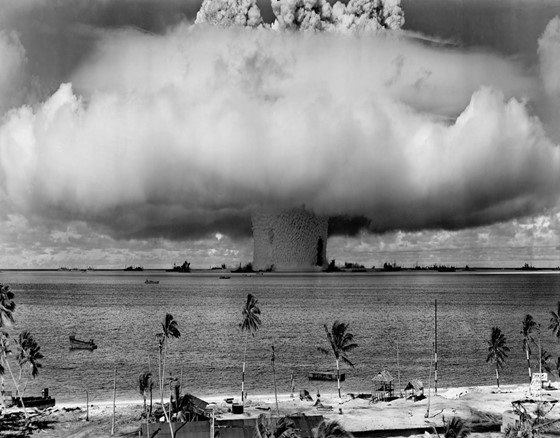
A nuclear explosion produces an EMP in three different phases. These are known as E1, 2 and 3. They are each produced in a slightly different way and have a slightly different effect, but they go together to make the EMP.
E1 is the first phase. It is a very brief but very strong electromagnetic field. It descends down from the explosion and travels at 90% the speed of light. It is caused when the gamma radiation produced by the explosion ionizes atoms in the atmosphere. The subatomic radiation particles strip electrons from the atoms, which gives the atom a positive charge. This positive charge flows through the atmosphere producing a radial pulse of electric current. When electronic components get in the way of this pulse, it fries them. Most components have surge protectors, but they are not designed to withstand a surge that grows in nanoseconds. There are some surge protectors that can withstand it, but they are not installed in most common devices. Because the pulse travels at 90% the speed of light, it is gone in nanoseconds.
E2 is the next phase. E2 consists of scattered gamma rays produced by neutrons. This is very similar to the current surge produced by a bolt of lightning. A lot of electrical components on Earth have protection against lightning strikes, so this is the least dangerous part of the EMP. However, it follows microseconds after the E1 phase and the E1 pulse could have destroyed any lightning protection, living the device vulnerable.
The third part is E3 and this lasts from seconds to minutes. This is the movement of charged particles that are produced by the heated plasma fireball as it interacts with Earth’s atmosphere. It is very similar to a solar flare. This can produce enormous power surges into powerlines and communications lines.
In July, 1962, the American government tested a 1.44 megaton nuclear weapon 400 km above the Pacific Ocean. The warhead was relatively small, but it still caused electrical damage in Hawaii, 1,445 km away.
All three of these phases coming one after another can destroy unprotected electrical components. However, it is possible to protect against a nuclear EMP. Physicist Enrico Fermi predicted that there would be an electromagnetic pulse created by a nuclear weapon. The US military tried to protect all of their electrical components before the very first nuclear test in 1945. They still lost some of their equipment. They were also worried that if multiple warheads were used on one target, the nuclear EMP from the first warhead would knock out the electrics in the others and make them ineffective.
The main ways to protect against a nuclear EMP are to shield the electronic components with a case that can deflect the electromagnetic wave. Copper is the most effective metal and it is possible to shield a whole building. Sophisticated surge protection technologies are also available. If the charge from the EMP exceeds a set limit, they can shunt it away from any circuitry. They can work fast enough to deflect the E1 phase of the nuclear EMP. There are a lot of other technologies available but most devices you buy for your house won’t have them. It costs money to protect a device from an EMP and it will raise the cost of your device without giving you any useful benefits because the chances of actually being hit by an EMP are so low as to not be worth thinking about. Unless you are working for the government, it is not really something you need to think about.
Some countries have designed nuclear bombs that have a much greater electromagnetic pulse than usual. The idea behind these bombs is to wipe out as much of an enemy’s infrastructure as possible.
America has been working on EMP weapons that use high power microwaves instead of a nuclear bomb blast. These are called e-bombs. They are apparently very expensive, so only a country with a lot of military money to spend can afford them. According to CBS, America used one of them to knock out Iraqi satellite television in 2003. The research into e-bombs is classified, but I think we can safely assume that America has advanced the weapons considerably since then. An e-bomb doesn’t have the political fallout that a nuclear bomb would have because it only destroys infrastructure and doesn’t harm people.
So, a nuclear EMP is an enormous electromagnetic pulse that is released when a nuclear bomb goes off. It ionizes the atmosphere and causes a wave of positively charged atoms to spread out. When they contact electronic devices and circuits, they can fry it with a surge of power. And this is what I learned today.
Photo by Pixabay: https://www.pexels.com/photo/grayscale-photo-of-explosion-on-the-beach-73909/
Sources:
https://en.wikipedia.org/wiki/Nuclear_electromagnetic_pulse
https://en.wikipedia.org/wiki/Ionization
https://doh.wa.gov/sites/default/files/legacy/Documents/Pubs//320-090_elecpuls_fs.pdf
https://www.wbdg.org/resources/high-altitude-emp-effects-protection
https://www.techtarget.com/whatis/definition/e-bomb-electromagnetic-bomb
